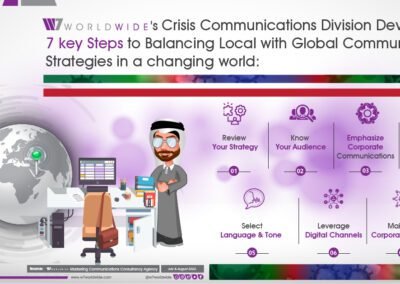The pandemic caused the largest and fastest disruption in history to international trade, global supply chains, and international travel. After a period of globalization, companies needed to review and adapt their strategies and operational models. As the world’s trading systems recover from the pandemic shock, a more connected digital world offers the best prospects for a sustainable future. Leaders need to plan for a world where both globalization and local priorities will continue to shift, with local relevance climbing the corporate agenda for global businesses.
Pandemic Brought us Closer
The pandemic called for a more agile global operating model to enable companies to stay closer to local suppliers and customers while reducing their operating risks. Businesses have to strike the right balance between local market needs and global strategy, supported by the right communications strategies. The rapid growth of the digital economy makes it important for brands to understand the cultural norms, target audiences, stakeholders, and regulatory policy across every market they operate in.
Each country is moving at a different pace and tackling its economic recovery in different ways. Saudi Arabia and the UAE have been ranked first and second globally as the best places to be during the pandemic. The Kingdom’s digital capabilities and predictions of a strong economic recovery saw it rise 18 places to the No.2 spot in Bloomberg’s COVID Resilience Ranking Report for January. What people experience is not the same everywhere, which means communicators need to think regionally and locally when it comes to PR.
7 Steps for Your Global Outreach
The current move to localization may not be with us to stay as countries will focus again on promoting global economic growth but in the interim a brand and what it stands for needs to be expressed depending on location and cultural context and adapted to local needs and sensitivities. For international organizations, the motto ‘act local, think global’ has never been more relevant in the post-Covid world. As part of having to overcome the disruption created by the pandemic, companies also have to cope with the consequences of climate change and new economic structures, such as the re-shoring or near-shoring of specific sectors in the long term.
The biggest challenge facing international brands looking to succeed is the lack of a good, localized strategy, as they tend to build a single regional or global strategy without consideration of each country’s unique culture. Localization and creating communication strategies that appeal to the various public in the Arab world is the main focus of W7Worldwide’s business model. Here we share the 7 key Steps to Balancing Local with Global Communications Strategies in a changing world:
- Review Your Strategy
The pandemic has had a profound effect on the way companies operate and communicate with their publics and customers. There is a greater need for localization of communications that aligns with relevant and most up-to-date in-country public policy and messaging to support national recovery and also climate change mitigation efforts. Being able to tell your story to the right audience at the right time and in the right way puts communications at the forefront for all organizations.
An effective localization strategy is a company’s plan and approach to adapting its content and messaging in different countries. This means addressing the language, culture, customer behaviour, and social norms. The purpose of your localization strategy is to make your communications more appealing to each audience’s preferences. The goal is to present your brand as one created specifically for your target market, irrespective of their native language, local culture, or religion.
- Know Your Audience
You cannot produce an effective localization strategy without understanding your audience. There is important research that must be carried out to avoid potential damage to your brand reputation or even offend your target audience if you get your messaging wrong. Understand your target markets, languages spoken, culture and societal attitudes, purchasing habits and behaviours, and the media landscape.
It is best to get to know your audience by working with a local partner who really understands the needs and values of your market. In working with local experts, you will receive accurate, localized expertise and insight on whether there is demand for your product, your local competition, how people purchase, and key cultural differences.
Part of carrying out local research is to get cultural nuances and imagery right. Consider your branding, as certain colours or symbols can have controversial meanings in different regions and cultures. Understanding your local audience is the most important part of your communications strategy, as it will provide the structure and platform for everything you do.
- Corporate Communications
Corporate communicators must have a deep understanding of localism in establishing a company’s reputation in the domestic market whilst managing stakeholders’ expectations of the corporate entity. They need to turn global strategies into local communication plans, backed with evidence of the organization’s commitment to the local market. The new environment we live in requires new behaviour, a new way of life, and authentic interactions between people and organizations.
Companies have had to consider how to maintain a solid reputation, from external to internal communications, Covid-19 crisis management, and CSR initiatives. This is where corporate communications draw all communications activity together in an integrated manner to provide clarity of purpose and implement consistent messaging. Companies should participate in localized CSR initiatives to demonstrate their commitment to the communities they serve and reinforce their overall corporate values.
Concepts such as vision, purpose, and core values must be seen as essential truths that underpin the overall corporate reason for being.
- Autonomy
Tailoring corporate communication to local markets has become more important since the pandemic. At the same time, the media, pressure groups, influencers, and investors have become global, and this global perspective has made local reputation critical. A local reputation issue can quickly grow into a global crisis. It is therefore vital to tailor global strategies to local circumstances and markets.
The global strategy sets out the overall framework that then needs to be aligned with local needs with the two interconnected. The local communications team will require the right level of autonomy and expertise, as they are the ones navigating the local landscape. The way a campaign is run and the content that is used to promote a corporate brand may differ greatly between countries and regions. Combining local and global communication brings new perspectives and knowledge to a brand. It is important therefore to get the balance between global and local communication objectives right. For listed companies there is also the issue of corporate governance to consider and how best to control the communications strategy centrally whilst giving local communicators sufficient autonomy.
- Language & Tone of Voice
Communicating with your audiences in a way that resonates with them will harness better connections. Language is just one part of your localization strategy and localization is not the same as translation. For example, it is extremely difficult to translate between Arabic and other languages, which produces sentences that are a paragraph in length without punctuation and full of adjectives. It is best therefore to avoid translation altogether. Companies wishing to establish a foothold in the region should instead build either internal or external partnerships with local partners to ensure communication messages are relevant, understood clearly, and in the right tone of voice.
While Western audiences expect public communications to be emotionally cool and reserved, in the Arab world a variety of factors contribute to a preference for emotionally expressive and engaging communications. Demonstrating emotion in media interviews is vital in gaining the trust of stakeholders and target audiences. The cultural value orientations that influence Arab culture, such as commitment to religion, devotion to the group, attachment to history, and recognition of hierarchal order, all influence the public relations strategies in the region.
- Digital Channels
When a company embraces a comprehensive localized communication strategy, it will build rapport and influence customer engagement. Crafting the perfect localized communication strategy means researching how the target audience will consume your content online. Your company can strengthen its branding by dissecting factors such as whether your audience engages with your brand through mobile or desktop platforms and the type of language and keywords they use.
With the aid of powerful platforms and analytics tools, companies can access data to carefully tailor their brand’s outreach. By customizing their localized communications campaign, they are able to create a unified digital brand experience that won’t get lost in translation. Understand and customize your communications carefully to the customer journey that takes them to your product or service in your target market. From the moment a person visits your website, social media channels, or receives an email, brands need to engage in a way that resonates with them.
The benefits of localizing your digital strategy are the ability to provide target audiences with information in their own language, it enables you to target specific markets and it will improve your search engine ranking in the relevant geographies.
- Corporate Culture
With increased scrutiny of global corporates in domestic markets, communicators need to understand how to translate global strategy into authentic localised outputs that convey the organization’s culture. Developing and maintaining a strong corporate brand strategy and culture internally is the starting point to then apply a specific market perspective to this strategy and develop external communications that are authentic. That way the business ensures it is not communicating in one market in a way that contradicts another.
Before Covid-19, CEOs often struggled to understand the value and business relevance of corporate culture. The crisis has shown us that a strong corporate culture ensures loyalty to the brand and company because the values resonate with employees, customers, and other target audiences. Corporate culture is organic and provides the platform to continually reinforce best practices and bring the company values to life.
Companies have to communicate with consistency to reinforce their common value set and proposition wherever they operate, whilst also understanding that different audiences have different needs and expectations.
We now live in a world where global brands can no longer apply a standardized communications strategy and need to achieve the right balance between globally consistent and locally relevant messaging. Certain future trends are common across all geographies, such as environmental stress, accelerating technological change, the increasing importance of information, and economic transition. The unprecedented acceleration in the speed of change represents a strategic challenge that requires a strategic response. Leaders and communicators must develop agility to enable continuous adaptation.
Moving Forward
The notion that an organization and what it stands for can be expressed regardless of the location and cultural context no longer applies. An effective localization strategy is the most important step to expanding your business and building a platform capable of tailoring communications to specific regions. Localization connects with target audiences on a personal level and builds the brand image in a way that is both accessible and unique. Ultimately localization is about building trust.
By positioning the brand behind a core mission and fulfilling that mission with local sensitivity, brands can navigate language barriers and cultural differences.



